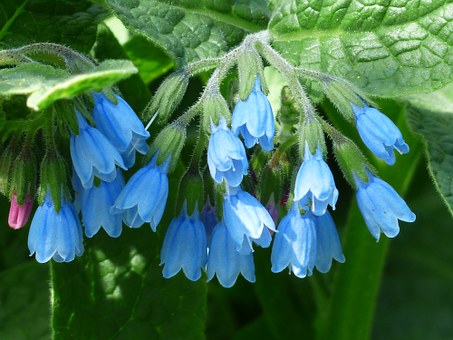|
Previously, comfrey was used in its tea form to aid in treating stomach problems, as well as ulcers, heavy menstrual periods, diarrhea, bloody urine, persistent cough.. but experts have raised the alarm on consuming it, as it contain toxic substances called pyrrolizidine alkaloids (PAs), which damage the liver.
|
Comfrey
The Common Comfrey is a rather coarse-growing
perennial attaining 3-4 feet, but the white-flowered variety, which grows wild in the Winchester water- meadows, is only about 18 inches. The latter is the more attractive plant. It sows itself profusely and should be propagated from seed gathered as soon as ripe, which is usually in late August or early September. Sow in drills half an inch deep and put out the plants a foot apart as soon as they are large enough to handle. Many of the beneficial properties of comfrey are attributed to its high content of allantoin, a substance that helps promote new skin cell growth, along with other substances that may work in reducing inflammation and maintaining healthy skin. Comfrey can help you naturally address skin issues such as scratches, rash (including diaper rash), bug bites (particularly spiders), and shallow wounds. It is also deemed helpful easing pain from arthritis, muscle aches, and soreness. |
- Home
- Introduction
- Choose your Plan
-
Choose your Plants
- Alecost
- Anchusa
- Angelica
- Balkan Sage
- Balm
- Basil Sweet & Bush
- Bergamot
- Borage
- Calaminth
- Camphor Plant
- Caraway
- Catmint
- Chamomile
- Chervil
- Chives
- Clary
- Comfrey
- Coriander
- Dill
- Elecampane
- Fennel
- Fennel Florence
- Feverfew
- Garlic
- Germander
- Giant Catmint
- Herb Patience
- Horehound
- Hyssop
- Lad's Love
- Lady's Maid
- Lavender
- Lily of the Valley
- Lovage
- Lungwort
- Mace
- Mallow
- Marigold
- Marjoram
- Melilot
- Mints
- Old Lady
- Parsley
- Pennyroyal
- Rose
- Rosemary
- Rue
- Sage
- Salvia Virgata Nemorosa
- Santolina Chamaecyparissus
- Savory
- Sorrel
- Sweet Cicely
- Tansy
- Tarragon
- Thyme
- Vervain
- Woad
- Wormwood
- Workshops
- Q & A
- Blog
- Contact
- Home
- Introduction
- Choose your Plan
-
Choose your Plants
- Alecost
- Anchusa
- Angelica
- Balkan Sage
- Balm
- Basil Sweet & Bush
- Bergamot
- Borage
- Calaminth
- Camphor Plant
- Caraway
- Catmint
- Chamomile
- Chervil
- Chives
- Clary
- Comfrey
- Coriander
- Dill
- Elecampane
- Fennel
- Fennel Florence
- Feverfew
- Garlic
- Germander
- Giant Catmint
- Herb Patience
- Horehound
- Hyssop
- Lad's Love
- Lady's Maid
- Lavender
- Lily of the Valley
- Lovage
- Lungwort
- Mace
- Mallow
- Marigold
- Marjoram
- Melilot
- Mints
- Old Lady
- Parsley
- Pennyroyal
- Rose
- Rosemary
- Rue
- Sage
- Salvia Virgata Nemorosa
- Santolina Chamaecyparissus
- Savory
- Sorrel
- Sweet Cicely
- Tansy
- Tarragon
- Thyme
- Vervain
- Woad
- Wormwood
- Workshops
- Q & A
- Blog
- Contact


